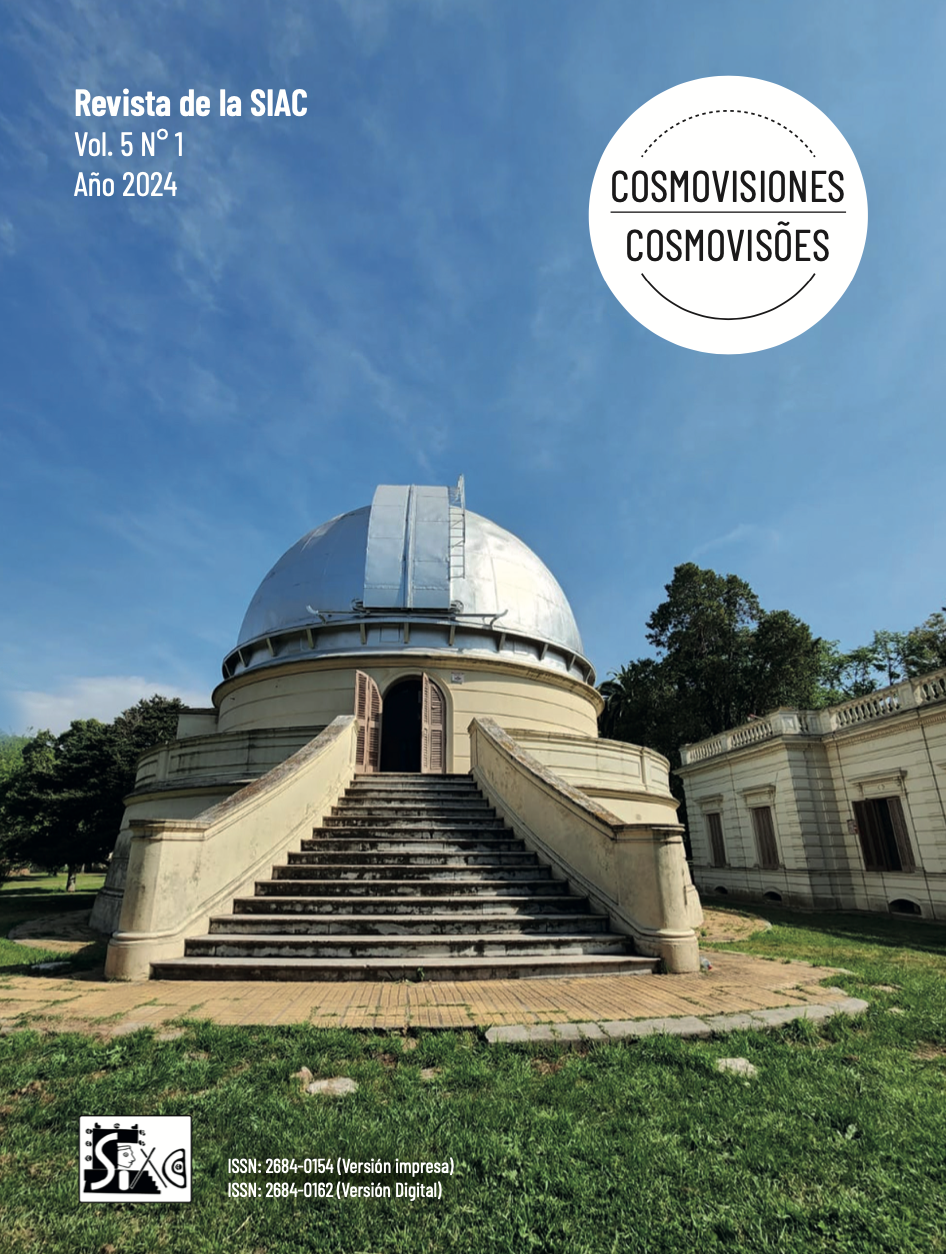Eclipse Prediction and the Length of the Lunar Month in Mayan Astronomy
DOI:
https://doi.org/10.24215/26840162e020Keywords:
tzolkinex, tritos, Maya lunar theory, Dresden Codex eclipse table, lunar seriesAbstract
One of the most remarkable achievements of Mayan calendrical astronomy was the in- vention of a lunar theory that combined a fixed lunar calendar with eclipse predictions. Eclipse predictions are shown in the Dresden Codex on pages 51-58. The lunar calendar is reflected in the Maya Lunar Series, which was attached to the chronological statements of Maya rulers displayed on monuments.
The so-called Eclipse Table covers 405 schematic lunar months, divided into 69 groups of 6 and 5 months each (D53a-D58b). It is preceded by a table of multiples of 11,960 days (D51a- D52a), the period covered by the table. The table structure generally exhibits three units with 23 eclipse possibilities each, of which twenty occur after six months and three after five months. Since each unit contains 135 months, the table includes 405 months (= 3 x 135) or three tritos series. Considering that each units warns about the possibility of 23 eclipses, the entire table allows warning about the possibility of 69 (= 3 x 23) eclipses. Some schol- ars, however, argued that the table originated from a tzolkinex, an eclipse period consist- ing of 88 synodic months. Both periods produce mean eclipse periods, which are more accurate than the saros.
Despite the Maya systematic alternation of 29- and 30-day lunar months, they devised a method to insert additional or leap days at regular intervals to track the lunar phases accu- rately. This method, known from the Lunar Table found at the Maya city of Xultun, is based on the record of 162 lunar months. The Xultun table is compatible with the intervals of 11960 days used in several Maya cities to perform lunar computations backwardly. in time.
This paper aims to provide a helpful and informative description of the records that are utilized to infer the mean values of the length of a half eclipse year and the average length of a lunation in Maya astronomy.
Downloads
References
Bricker H.M. and Bricker V.R. (2011) As- tronomy in the Maya Codices. Memoirs of the American Philosophical Society held at Phila- delphia for promoting useful knowledge Vol- ume 265. Philadelphia American Philosophi- cal Society.
Britton, J. B. (1989) An Early Function for Eclipse Magnitudes in Babylonian Astronomy. Centaurus 32: 1-52.
Espenak, F. and O’Byrne C. (2007) The Ja- vaScript Lunar Eclipse Explorer. Electronic publication. Javascript Lunar Eclipse Explorer Index Page (nasa.gov)
Hartner W. (1969) Eclipse Periods and Thales’ Prediction of a Solar Eclipse: Historic Truth and Modern Myth. Centaurus 14 (1), 60-71.
Iwaniszewski S. (2020) The Lunar Series and Eclipse Cycles at Palenque, Chiapas, Mexico. Estudios Latinoamericanos 40, 61-85.
Justeson, J.S. (1989) Ancient Maya ethnoas- tronomy: an overview of hieroglyphic sources. In Aveni, A.F (ed.) World Archaeoastron- omy, selected papersselected papers from the 2nd Oxford International Conference on Archaeoastronomy held at Merida, Yucatan, Mexico, 13-17 January 1986. Cambridge: Cam- bridge University Press. 76-129.
Justeson, J.S. (2017) A Cyclic-Time Model for Eclipse Prediction in Mesoamerica and the Structure of the Eclipse Table in the Dresden Codex. Ancient Mesoamerica 28 (2), 507-541.
Lounsbury, F.G. (1978) Maya Numeration, Computation, and Calendrical Astronomy. In Ch. C. Gillespie (ed.) Dictionary of Scientific Bi- ography, vol. 15, suppl. 1. New York: Charles Scribner’s Sons. 757-818.
Meeus, J. (1997) Mathematical Astronomy Morsels. Richmond: Willmann-Bell, Inc.
Querejeta M. (2011) On the Eclipse of Thales, Cycles and Probabilities. Culture and Cosmos 15 (1), 5-16.
Smiley, C.H. (1973) The Thix and the Fox, Mayan Solar Eclipse Intervals. Journal of the Royal Astronomical Society of Canada 67 (4), 175-182.
Smither, R. K. (1986) The 88 Lunar Month Pattern of Solar and Lunar Eclipses and Its Relationship to the Maya Calendars. Archaeo- astronomy, The Journal of the Center for Ar- chaeoastronomy 9, 99-113.
Teeple, J.E. (1931) Maya Astronomy. Con- tributions to American Archaeology, No. 2:29- 115. Publication 403. Washington D.C.: Carne- gie Institution of Washington.
Thompson, J.E.S. (1972) A Commentary on the Dresden Codex. A Maya Hieroglyphic Book. Philadelphia: The American Philosoph- ical Society.
Verbelen, F. (2001) Saros, Inex and Eclipse Cycles.
Downloads
Published
How to Cite
Issue
Section
License
Copyright (c) 2024 Stanislaw Iwaniszewski

This work is licensed under a Creative Commons Attribution-NonCommercial-ShareAlike 4.0 International License.
Authors who publish in this journal agree to the following terms:
The authors retain intellectual authorship of the work and guarantee the journal the right to be the first publication of the work.
Authors may share the work with acknowledgment of authorship and the initial publication in this journal.
Authors may separately establish additional agreements for the non-exclusive distribution of the version of the work published in the journal (for example, placing it in an institutional repository or publishing it in a book), with an acknowledgment of its initial publication in this journal.
The journal offers free access ("open access") to all its content. The articles are available to be read, downloaded, copied, printed and/or researched according to the Creative Commons license: CC BY-NC-SA (Attribution - Non-Commercial - Share Alike-4.0 International)

The content of the journal is fully available from its publication. Readers are required to correctly cite the journal and the author of the downloaded content
















